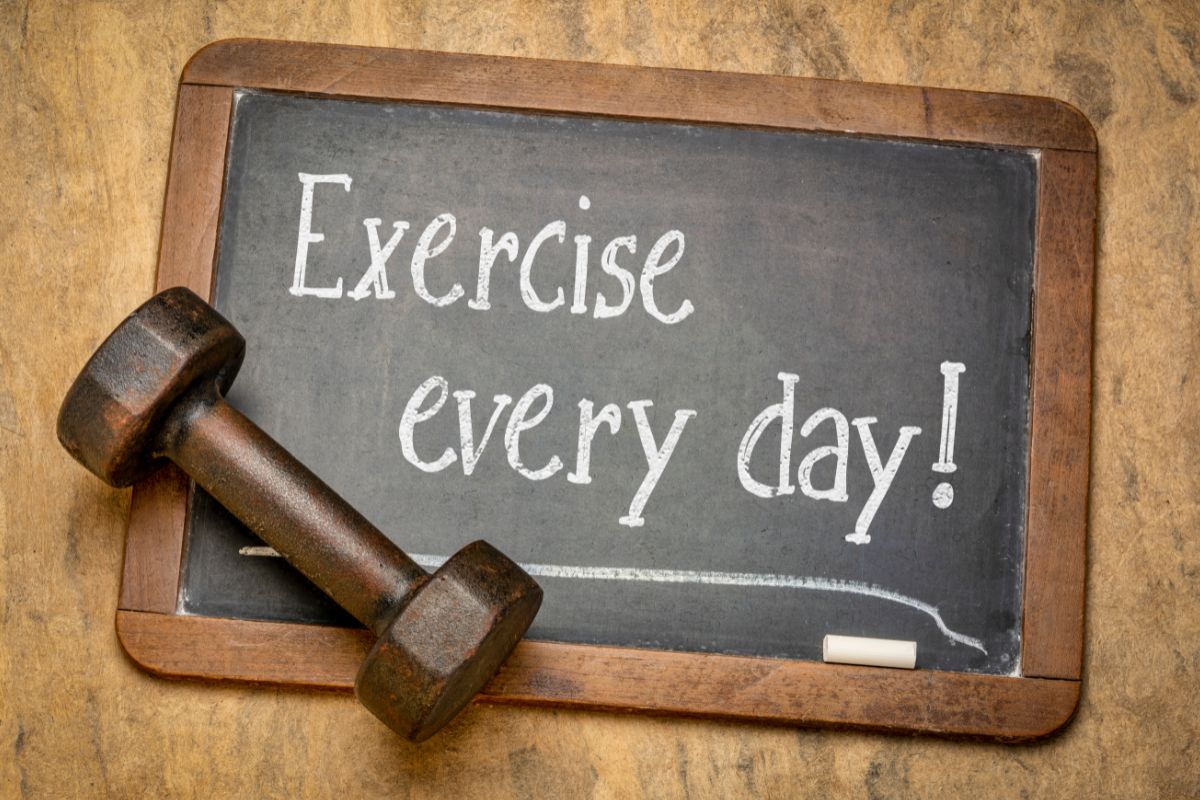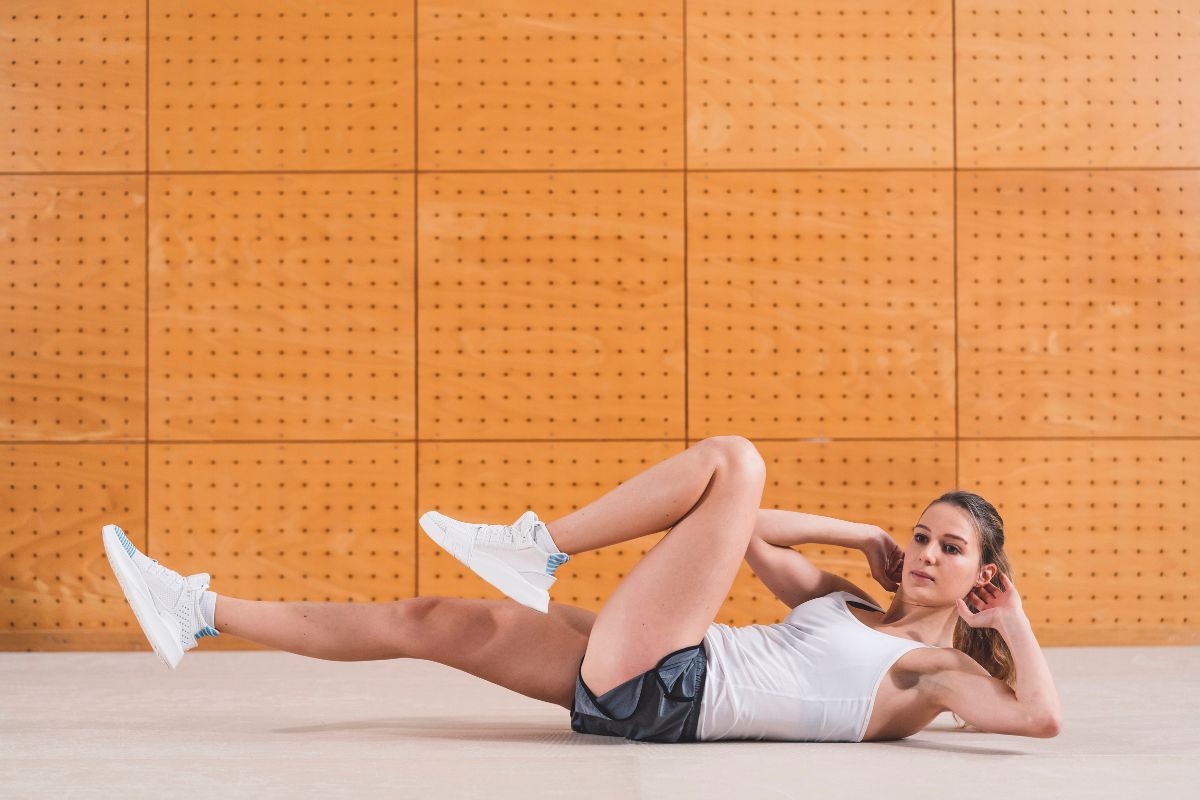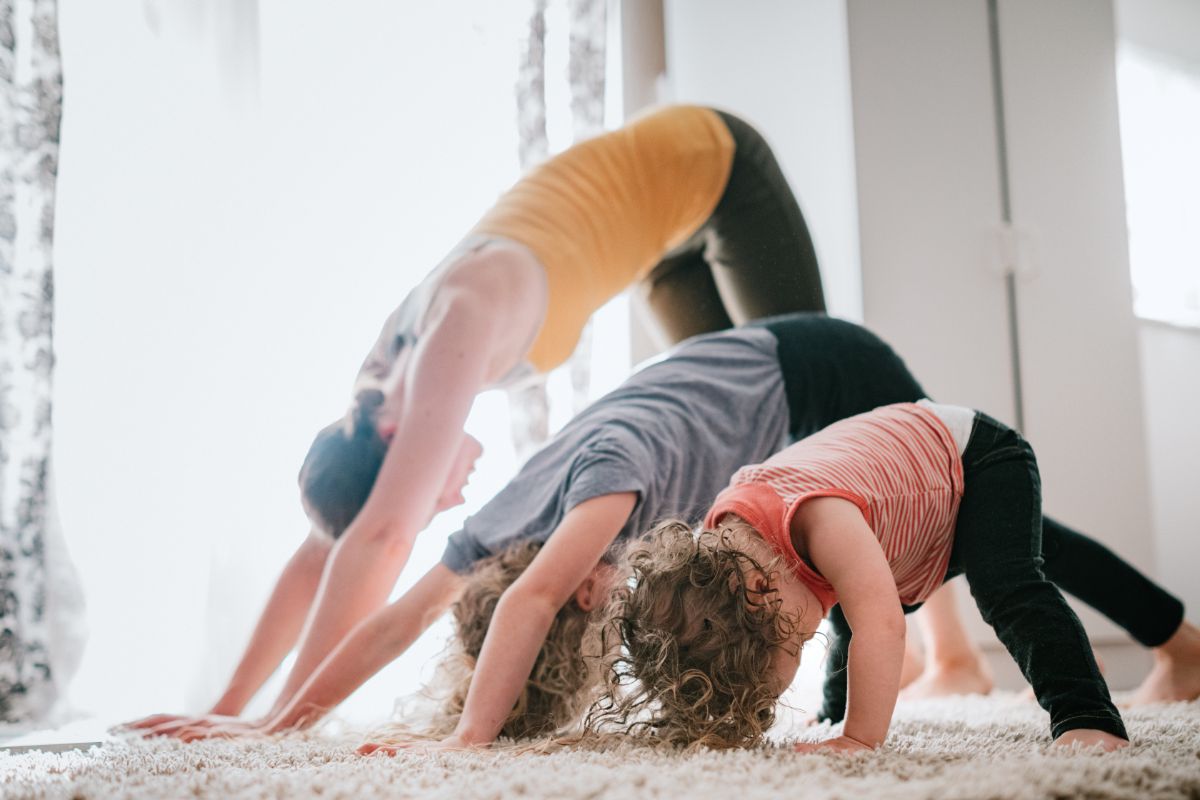Last Updated on November 20, 2022 by TJ Daniels, Certified Personal Trainer


If you’re looking for a new and challenging way to exercise, calisthenics is the way to go!
Many athletes consider calisthenic workouts as something boring. This is because a lot of us don’t feel considerable excitement for middle-school movements like jumping jacks and sit-ups.
Fortunately, the same calisthenics prescribed by gym teachers and drill sergeants for years has recently been rebranded as body weight exercises. These engage your core while targeting muscles all over your body.
Whether you’re exercising in your local public gym or from the comfort of your home, trying any new type of exercise can be scary.
It can also get a little repetitive if you religiously follow the same routine every day – or a couple of times a week, whatever your regular schedule is.
This is one area where using calisthenics to work out is ideal as there are many exercises for you to try ranging from beginner to advanced levels. One thing you need to know is that calisthenics is not a trend.
This is because it requires a solid blend of power, endurance, and body control to properly perform it.
If you’re not entirely sure about where to begin, or how to start conquering basic exercises like squats, you are definitely in the right place!
What Is Calisthenics?
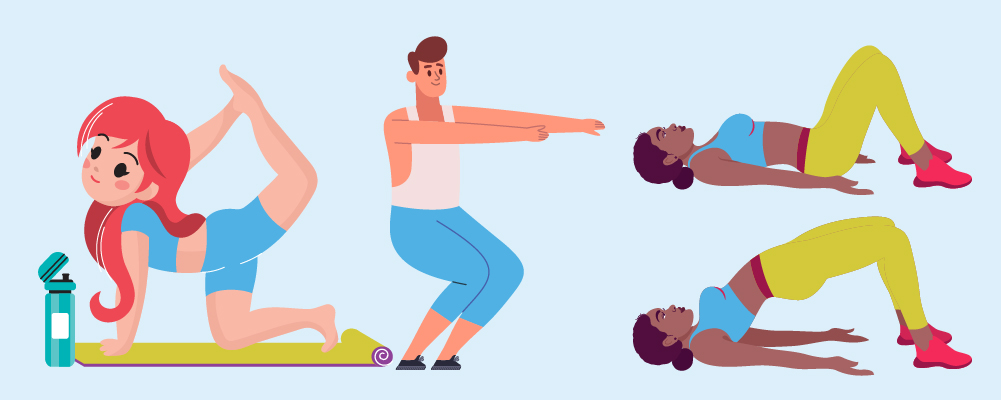

The term is derived from two Greek words. These are “Kalos” which means beauty, and also “Stenos” which translates as strength.
A calisthenic workout aims to use a person’s entire body weight with little to no equipment. Simply put, it uses both gravity and bodyweight leverage to properly challenge your fitness level.
It involves moderate movements that tend to use larger muscle groups such as pushups, with the overall goal of improving flexibility, strength, and coordination.
Calisthenics was created as a method of promoting health in school children. However, over the years, it has quickly started to share a lot in common with gymnastics.
One thing that makes calisthenics stand out is that it is a type of ‘secret’ workout that can also be practiced outdoors if needed.
Typical exercises range from simple movements to more advanced movements including muscle-ups which require the addition of relevant equipment to perform moves correctly.
The best part? Calisthenics is completely beginner-friendly and versatile, meaning it can be used to perfectly complement different training styles.
Calisthenics Equipment:


Though equipment isn’t a requirement when partaking in calisthenics, you are free to use it to add some additional resistance.
You can use lots of basic equipment in your calisthenics routine to push your training to the next level, which makes it great for beginners and experienced calisthenic enthusiasts alike.
Some of the main pieces of calisthenics equipment include:
- Parallettes: these are two bars on stands that sit parallel to one another. They are one of the greatest workout tools in gymnastics, functional fitness, CrossFit, and calisthenics. Parallettes are also excellent ways of training push exercises, L-sits, and dips for beginners. You can also use them while training handstands and planche.
- Pull-up Bar: a horizontal pole that you can use to “pull up” your body weight. There are three varieties: door frame-mounted, wall-mounted, and free-standing. This calisthenics tool is used to exercise your back muscles and your core body strength to create pulling movements including rows, pull-ups, back levers, and knee raises.
- Resistance Band: a thick elastic band that can be used to accommodate variable resistance. They are ideal for warming up before a workout or stretching after a workout. This gives you the chance to learn how to do exercises like muscle ups or pull-ups or make simple exercises like squats a little bit more difficult.
However, one of the main benefits of calisthenics is that it does not require equipment. You are using your body weight to perform exercises instead of the equipment, which makes it a great exercise for home workouts.
Is There An Ideal Diet For Calisthenics?


As you are likely already aware, the nutrition to exercise ratio is around 80% nutrition and 20% exercise.
Though this is true, it doesn’t mean that you shouldn’t put maximum effort into exercising! It simply means that this percentage will contribute to your total progress with calisthenics.
The aim of a calisthenics diet should be on refueling your body with nutritious food that will build lean muscle and reduce your body fat percentage.
The perfect diet will promote muscle gain, keep you lean, regulate your appetite, balance your body’s requirements, and optimize your recovery.
You must consider the following in your diet:
- The number of calories you consume
- Macronutrients and micronutrients
- Protein
- Carbohydrates
- Fat
Training Days
On the days when you exercise, you should consider consuming a higher amount of healthy fats and healthy carbs to restore energy levels and burn off saturated fat. Some of the best foods to eat on training days include:
- Avocados
- Eggs
- Wholegrains
- Full-fat Greek yogurt
- Seeds and nuts
- Legumes
- Lentils, pulses, and beans
- Lean meat
- Sweet potatoes
- Oils
Rest Days
During times when you are not planning to train, your aim should be to focus on consuming protein. This is so important as protein is what repairs our torn muscle fibers while also promoting lean muscle growth.
It’s also the key to building muscle mass, which is something that you need in calisthenic workouts.
You might want to try:
- Oats
- Chicken
- Lean beef
- Cottage cheese
- Flaxseed
- Salmon
- Pumpkin seeds
- Sardines
You should try to cut out as many processed foods and sugars as possible to lean out without needing to put excess effort into getting yourself into shape.
Calisthenics Or Weight Training?


It’s pretty common for beginners of calisthenics to consider the exercise and compare it to other exercises they already know quite a bit about. Sort of like how we look at multiple reviews of products before we buy them.
So, in the battle of calisthenics or weight training, it can be pretty difficult to make an informed decision about which one to choose! Fortunately, we’ve summed up the most prominent comparisons between the two for you to make your decision.
Pros And Cons
Calisthenics and weight training can either be performed as isolated exercises or as a complement to each other.
They are both forms of strength training that promote a range of individual benefits. However, this depends on what your overall fitness goals are.
In calisthenics, resistance comes from using your body weight. However, weight training requires additional external weight to perform the exercise properly.
You can also adjust this amount of weight which is an efficient way of increasing your strength and overall fitness levels.
But if gaining muscle mass quickly is your main goal, calisthenics isn’t the right exercise for you. This is because once you’re used to lifting your body weight you will likely struggle to build excess muscle mass.
However, lifting heavy weights to achieve some kind of gain is much more effective than using your body weight to see quick changes. This is because it’s generally much harder to hit some sort of plateau in this area.
And finally, if it’s convenience you’re after, calisthenics might be the perfect option for you. This is mainly because it is an excellent starting point for any beginner to learn the correct form for many types of exercise.
Benefits Of Calisthenics:


They’re Easy On Your Joints In Comparison To Other Exercises
Calisthenics is designed to help you move your body in many different ways which makes it a lot easier on your muscles, joints, and tendons.
This is mainly because you’re not lifting heavy weights and are instead focused on making sure the extremity of your body remains in contact with a fixed object.
As a result, it means there is a reduced risk of developing any type of injury – especially anything to do with your joints.
As you aren’t exerting yourself as much as other types of exercise, you will likely have a much quicker recovery time.
This means that your workload increases during your exercise experience and you’ll end up getting in more workouts without overexerting your body!
Make sure to take frequent breaks so that you are not pushing your muscles or joints past their usual capacity!
They Promote Mindfulness Through The Focus It Takes To Execute Movements
Conscious calisthenics calls for concentration and mindfulness of your mind and body. This is because a lot of people see calisthenics as a type of meditation.
If the movements are done slowly then they can become a little bit difficult. But taking the time to slow and control your breathing can also serve as a pretty consistent tempo for you to carry through the whole movement.
Once you begin to feel your body strengthening, you can slow down the exercises and begin timing your movements with your exhalations and inhalations. Not only will this calm your body but it will also serve to slow down your mind and improve focus.
One of the most prominent benefits of having a strengthened mind-body link relates to injury prevention. By practicing mindfulness it is easier to figure out when a move doesn’t feel quite “right”, or if something is feeling a little too strenuous on your body.
Armed with this knowledge, you can both prevent and avoid training injuries since you’ll be more in tune with what your body doesn’t respond well to.
You Gain Significant Control Over Your Body
There’s something quite special about feeling like you have complete control over your body when you work out. Yes, it’s pretty impressive when you can execute a heavy deadlift, but it’s just as impressive if you can complete a one-arm pull-up!
If you want to learn how to fully control your body of free will, calisthenics is an excellent exercise. It allows for exponential capacities of balance, full-body control, speed, and even flexibility.
This type of exercise is a full-body workout that does not target only one single muscle group. As a result, everyone who uses calisthenics properly and frequently will have a more naturally toned body.
In line with the above point about mindfulness, calisthenics will also help you to increase the control you have over your mind.
As a result, you will maintain complete control over your body, too, and push past any physical barriers you may encounter as you exercise.
You can begin by mastering an incline press-up and then a regular press-up which requires you to control far more of your body weight.
If you can do a few of these in a row then you may be ready to move on to more complex moves like dips. However, you must be able to fully, 100% control your body to do these correctly!
Your Mobility And Agility Will Soar
Calisthenics automatically improves your overall agility as you learn how to correctly master your body weight. These exercises will often need you to take your joints through a full range of motion which will quickly help to improve your mobility.
You can easily increase the load that you are putting your muscles under with an increased number of reps, longer sessions, or even less rest time to build up strength.
For example, it takes considerable ankle, knee, and hip flexibility to properly perform a full squat. To do other things like handstands and push-ups, you will also need good shoulder mobility.
Performing moves like the mountain climber will keep your body balanced and will engage key muscle groups from the very top to the bottom. This type of full-body workout not only builds strength but will also help to improve coordination and agility.
Put simply, doing calisthenics will make you far less likely to hurt yourself. You’ll also have the tools to move better in your everyday life!
You Can Do It Anywhere
Calisthenic exercises use your body weight as a form of resistance instead of relying on multiple pieces of equipment, meaning you can do them quite literally anywhere you want to!
Calisthenics training doesn’t require you to purchase a gym membership or travel to a specific destination to exercise.
This means you can save quite a bit of money by opting to learn how to perform calisthenics using free weights, resistance bands, or any other piece of useful home fitness equipment.
Whether you’re at home, in your local park, or even tucked away in a hotel room, there are plenty of effective exercises you can do to keep your fitness level up!
Being able to set the time, place, and schedule of your calisthenic workout increases the flexibility of your routine and ensures that you don’t miss out on valuable exercise time.
It’s Great For Beginners
Calisthenics is a great way of burning calories, boosting muscle strength, and setting you up on your fitness improvement journey whether you’re a beginner or have lots of experience with exercise. It’s also a great way to understand what proper form is.
The majority of calisthenic exercises are pretty simple which is one of the biggest reasons why they are considered to be beginner friendly.
If you’re relatively new to fitness, starting with your exercises can help you to learn about the correct form safely before you progress to more complex weighted exercises.
Calisthenics requires some patience to properly perform the moves. This means you can build your full-body strength over an extended period and in a much more sustainable fashion.
It also means you don’t need to stress too much about rushing to learn everything about calisthenics in a short period!
Once your strength begins to increase in one area, you can simply opt to increase the resistance to make the exercises more difficult rather than trying something completely different!
Quick 15-Minute Calisthenic Workout Plan:
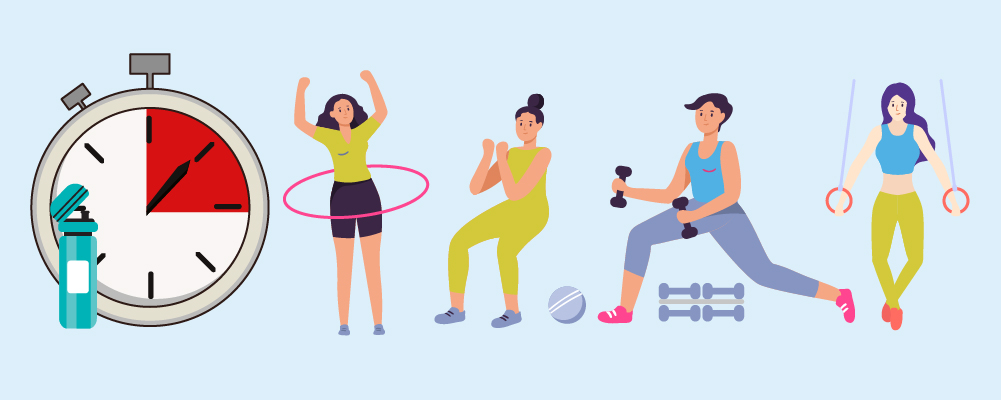

Strength training is an important part of any type of endurance workout regime. This is because it prevents any muscle imbalances, works to protect you from suffering any injury, and also increases your speed and stamina.
The bodyweight workouts provided by calisthenics are a very effective way to train all three at once!
Perform each of the exercises below for 40 seconds, rest your body for 20 seconds, and then move on to the next exercise. Complete this for a total of 15 minutes.
Try to finish doing more reps in the allotted time frame while ensuring that you maintain proper form for a successful calisthenic workout.
Jump Squat


Stand tall with your feet located shoulder-width apart. While you’re in this position, make sure to keep your hands located behind your bed.
From this point, move your body into a squat and then squat down until your legs are parallel to the ground – or as close to this as possible.
While in this position, make sure to keep your back neutral and your chest up. To properly maintain this position you must forcefully extend your knees, ankles, and hips so you can jump straight back up as high as you possibly can.
You must then land softly on the ground and immediately begin lowering yourself back to a squat before you spring back up to your normal position.
Triangle Push-Up
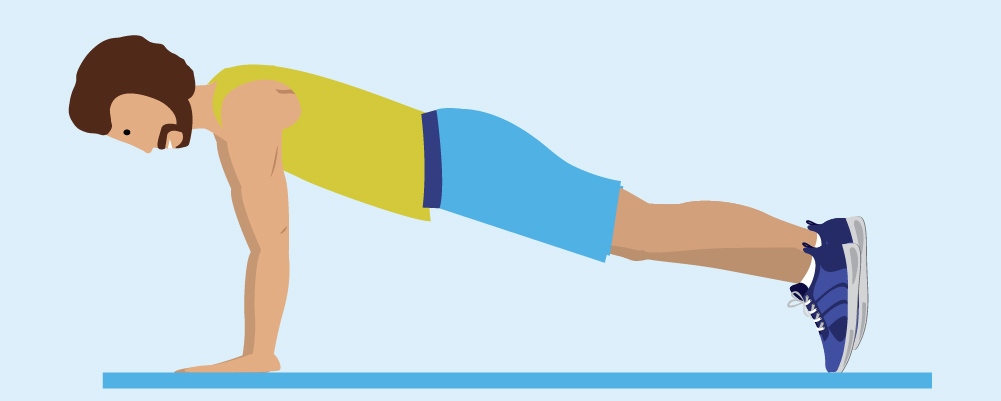

The triangle push-up or the diamond push-up is the more advanced variation of the classic push-up. It’s pretty much the same but comes with a slight difference in the positioning of your hands.
The move invites you to turn the pits of your elbows toward one another.
Get yourself onto the ground in a high plank position with your hands positioned in line with your shoulders and directly under the center of your chest. Make sure that your thumbs and index fingers are touching to form a triangle.
If you’re positioned properly, your body should now form a straight line from your head to your heels. From this correct position, slowly begin to bend your elbows to begin lowering your body until your chest is hovering just a few inches above the floor.
Pause for a second and then reverse the movement to return to the starting position.
Bicycle Crunch
This move will help you to build a strong core by activating your abdominal muscles. Besides working your abs, you’ll also be able to tone your thighs with this movement.
Lie flat on the floor with your lower back pressed directly to the ground with your knees bent. Raise your hands to the sides of your head and make sure your legs are bent so that your shins remain parallel to the ground.
Brace your core to ensure that your body remains in contact with the ground throughout the entire exercise.
After this point, you must squeeze your abdominal muscles to lift your upper back off of the floor and then bring an elbow up so that it meets the opposite knee.
As you do this, make sure to extend your other leg so that it remains straight out a few inches above the floor. Once this is done, immediately switch sides.
Speed Skater
Also known as skater jumps, a speed skater is an excellent plyometric exercise that actively targets the cardiovascular system in addition to increasing lower body power and strength.
It requires very little space and no equipment at all, making it the perfect exercise to incorporate into your exercise routine. Stand on your right leg while keeping your left toe on the ground behind you so that you can maintain your balance.
After this point, you must bend your knees and your hips so they are angled toward the ground and then spring back up and hop onto your left foot, allowing your arms to swing with you.
As you come back to land, move your right foot behind you to keep your balance. After completing the exercise with one leg, immediately move to the other one.
Forward Lunge
This is one of the more straightforward calisthenic moves on this list, and one of the best for beginners everywhere! Stand tall with your back straight and your feet hip-width apart.
You also need to keep your hands clasped at the front of your chest to keep your balance.
Take a large step forward with one of your legs, bending at the knees and hips until both of your legs form 90-degree angles. At this point, your knees should be positioned directly over where your ankles are.
Put your energy into pushing through the base of the foot at the front of the lunge to reverse the movement and get back to the original position. Make sure to repeat this on the other side of your body.
Straight-Leg Raise
Position yourself on the floor, face up. Keep your legs together and place your hands either underneath your glutes or by your sides for balance. One of the most important things to do here is to brace your core.
From this position, and while keeping your legs together and as straight as you possibly can, begin squeezing your abs to slowly begin raising your legs.
Make sure that your legs move until your thighs end up perpendicular to the ground. Your final aim will be to reach around three inches off the ground.
After achieving this, reverse the motion and return to your starting position.
Bodyweight Hang/Pull-Up
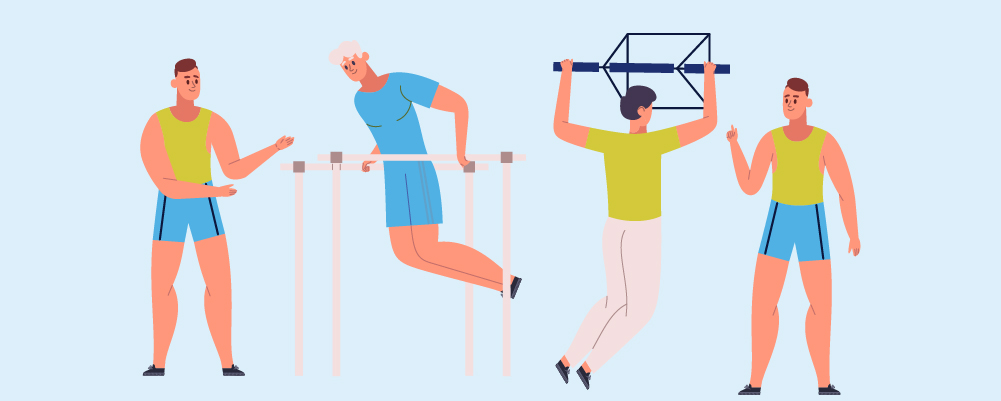

A bodyweight hang is a relatively straightforward bodyweight exercise that actively targets the muscles in your upper body. However, it may be a little more difficult for beginners.
Regardless, it’s a great way of engaging your whole body without needing to purchase or use any specific equipment.
Stand underneath a low and sturdy tree branch and reach up to grab one of the branches with a grip that extends just a little bit over shoulder width. Of course, you could use a sturdy overhead bar, too, if you have access to one.
With your arms fully extended, make sure to brace your core and fully bend your knees to begin lifting your feet towards your glutes.
Maintaining a tight core, hang for a set amount of time. If you have the strength, pull your shoulder blades together and try pushing yourself into a pull-up.
Lateral Lunge
Also referred to as a side lunge, this particular move is great for working all of the muscle groups throughout your lower body.
Begin by standing upright with your feet hip-width apart and with your hands clasped tightly in front of your chest to remain balanced.
Take a big step to the side with your right leg, bending your hip and knee until your thigh is perpendicular to the ground, with your knee located directly over your ankle. Make sure to keep your left leg completely straight at this point.
Push from the base of your right foot to reverse the movement and then repeat on the other side of your body.
Side Plank (Left)
This is an exercise that consists of maintaining a position resembling the plank but towards the left.
Lie down on your left side on the ground with your left forearm under your shoulder, your left hip resting directly on the ground, and your right foot stacked on top of your left foot.
You must then brace your core and lift your hips at the same time so that your body turns into a straight line from the top of your head to your toes. Hold this position for the set time.
Side Plank (Right)
Much like the left side plank, this involves taking the classic plank position but laying on your right-hand side.
Keep your right forearm under your shoulder with your right hip resting directly on the ground, with your left foot on top of your right. From this point, make sure to brace your core and lift your hips.
This will put your body in a straight line. Hold the position for the specified time.
Mountain Climber
This move is a challenging one but is generally very effective at engaging the muscles throughout your body including your calves.
Begin by placing yourself into a traditional plank position with your hands directly positioned underneath your shoulders. Your body should remain in a straight line at this point.
After this point, and with your toes secured to the ground, you must brace your core for balance and bring one of your knees to your chest. Quickly change sides and move your foot back toward the ground while raising the opposite knee to your chest.
Wide-Handed Push-Up
Like other calisthenic exercises, you must make sure to use proper form so that you do not injure yourself and also ensure that all of your muscles are engaged.
Put yourself onto the ground in a high plank position with your hands positioned on the floor slightly wider than shoulder width, and directly in line with your shoulders.
Once your body forms a straight line you can slowly begin bending your elbows to lower your body towards the ground until your chest is just a few inches above the floor.
You must then pause for a second and then begin reversing the movement to start all over again. Repeat for the remaining amount of time.
Summary
This brings our beginner’s guide to calisthenic workouts to a close. We hope that this information has sparked your desire to try a calisthenic workout for yourself or to at least learn more about this type of exercise.
One of the best parts of a calisthenic workout is that it is completely versatile.
This means you can tailor it to suit your exact needs or to cater to any limitations that you may be facing in terms of your fitness (whether that is a physical injury or a mental block).
Calisthenics isn’t the best choice for everyone but there are so many benefits to this type of exercise that it’s often difficult to see any cons!
With its accessible and adaptable nature and plenty of opportunities to progress your exercise routine, calisthenics is an excellent way of training for individuals who love to challenge their fitness abilities.
Knowing where to start can be pretty tough as there are so many exercises to try. But hopefully, you now have a good idea of what type of exercises you can try as a beginner for this type of workout!
- How To Start HIIT Workouts [Beginner’s Guide] - May 18, 2023
- How To Sneak A Workout In While Taking Care Of Your Baby - March 17, 2023
- How To Build Your Chest With Dumbbells [Guide] - February 9, 2023




